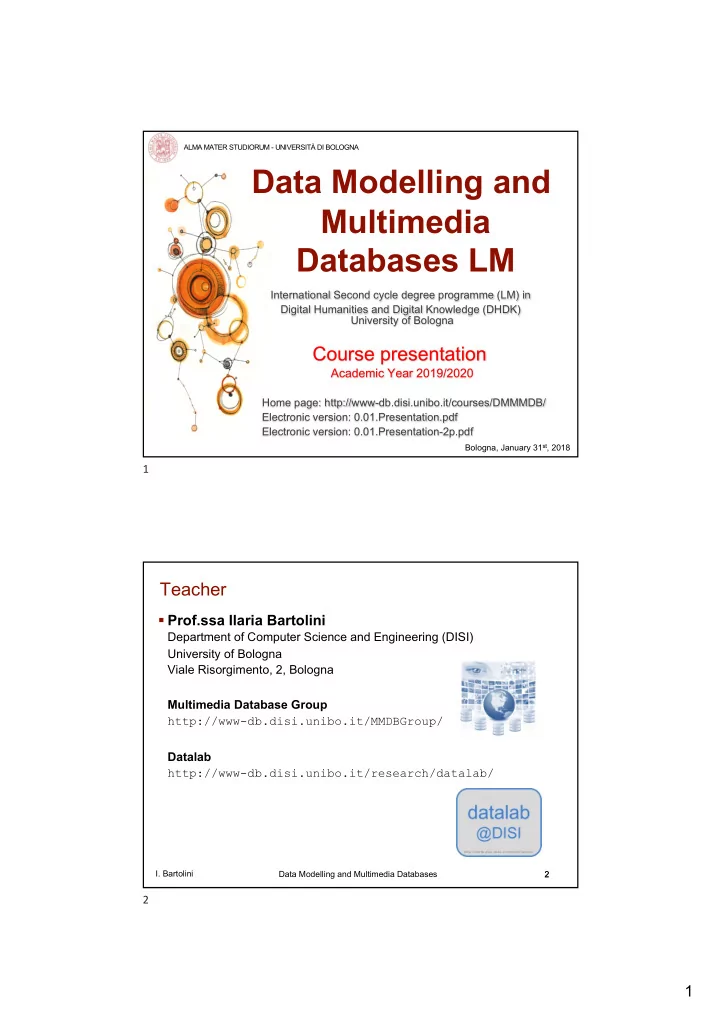

ALMA MATER STUDIORUM - UNIVERSITÀ DI BOLOGNA Data Modelling and Multimedia Databases LM International Second cycle degree programme (LM) in Digital Humanities and Digital Knowledge (DHDK) University of Bologna Course presentation Academic Year 2019/2020 Home page: http://www-db.disi.unibo.it/courses/DMMMDB/ Electronic version: 0.01.Presentation.pdf Electronic version: 0.01.Presentation-2p.pdf Bologna, January 31 st , 2018 1 Teacher § Prof.ssa Ilaria Bartolini Department of Computer Science and Engineering (DISI) University of Bologna Viale Risorgimento, 2, Bologna Multimedia Database Group http://www-db.disi.unibo.it/MMDBGroup/ Datalab http://www-db.disi.unibo.it/research/datalab/ I. Bartolini Data Modelling and Multimedia Databases 2 2 1
Contacts § E-mail: § ilaria.bartolini@unibo.it § Telephone: § 051 20 93550 § Web: § http://www-db.disi.unibo.it/ibartolini/ § Office hours: § by appointment (via email) I. Bartolini Data Modelling and Multimedia Databases 3 3 General information and course calendar § Name: “ Data Modelling and Multimedia Databases LM ” § Credits: 6 § Teaching hours: 30 hours § Period: III § February 3 rd , 2020 – March 13 th , 2020 § Teaching hours: § Wednesday – 9:30-12:30 § Friday – 14:30-17:30 § Room: AULA AFFRESCHI, - Via Zamboni, 34, 36 - Bologna I. Bartolini Data Modelling and Multimedia Databases 4 4 2
Course contents § Learning outcomes The course aims to initiate the students to data modeling , firstly by reflecting on content type : starting from traditional metadata , continuing with regular (textual) documents , and concluding with most complex multimedia documents . At the end of the course the students will be able to: § master the principles and fundamentals of documents’ database management; § master the most suitable methods of documents’ content description, together with their indexing techniques and query paradigms; § evaluate the quality of provided results through quantitative metrics; § be familiar with the state-of-the-art of multimedia database management; § analyze the requirements of specific contexts in the cultural heritage domain in order to identify the most appropriate solutions for modeling and managing the underlying data. § Topics at a glance § Basics on structured, semi-structured, and unstructured data modles § Textual Information Retrieval § Multimedia Information Retrieval I. Bartolini Data Modelling and Multimedia Databases 5 5 Main goal § Facilitate and improve the “access” to documentary data repositories for general users , conjunctively exploiting: § dedicated users manually provided metadata Models, § low level features (e.g., document keywords, color of an image) Algorithms, Interfaces § semi-automatically provided annotations Archivio Storico Fiat Cineteca Archivio Artistico § Trimotore Fiat G212 § Das Cabinet des Dr. Caligari § La Gioconda § Data: 1947 § Data: 1920 § Sito: Museo Louvre, Parigi § Collezione: Tema di cultura § Nazione: Germania § Secolo: XVI industriale § Regista: Robert Wiene § Autore: Leonardo da Vinci § Tipologia: Immagine § Genere: Horror § Periodo: Rinascimento § Aereo, Motore, Ali § Espressionismo, Ipnosi, § Data: 1503 Sonnambulismo § Dipinto, Ritratto, Sorriso I. Bartolini Data Modelling and Multimedia Databases 6 6 3
Detailed program § Data types classification § Basics on structured, semi-structured, and unstructured data § Concepts of data modelling § Textual Information Retrieval (IR) systems: general principles § Documents representation in IR systems § Automatic indexing techniques, stemming, stoplist § Searches of Boolean type § Searches of phrases and for proximity § The Vector Space model: weighing techniques and ranking of the results § Evaluation of IR systems: Precision and Recall metrics § Multimedia Information Retrieval (MM-IR) § General concepts of MM-IR systems: feature extraction and similarity criteria § Examples for different types of multimedia data § Query paradigms and presentation of the results § Interactive searches I. Bartolini Data Modelling and Multimedia Databases 7 7 Course home page http://www-b.disi.unibo.it/courses/DMMMDB/ Contents : § News § Copy of teaching materials and slides in PDF format § Bibliography § Useful links § Assessment methods § Exam sessions I. Bartolini Data Modelling and Multimedia Databases 8 8 4
Readings/Bibliography § Education material provided by the teacher § copies of the slides used in the classroom § relevant scientific literature and useful readings § links to real multimedia documents collections I. Bartolini Data Modelling and Multimedia Databases 9 9 Teaching methods § Course lectures are in “traditional” classrooms and exploit the slides § Several real use cases will be presented in order to show how such information technologies can be profitably applied in a number of real applications in the cultural heritage domain § Practical exercises , based on the multi-medial interactive blackboard (or LIM) will be carried out collegially I. Bartolini Data Modelling and Multimedia Databases 10 10 10 5
Assessment methods § The exam evaluation consists of an oral examination § To participate to the exam, interested students have to register themselves by exploiting the usual UniBO Web application, called AlmaEsami I. Bartolini Data Modelling and Multimedia Databases 11 11 11 Examination sessions § Six examination sessions per year divided as follows: § Two sessions before the summer § Starting from September, at the request of the students I. Bartolini Data Modelling and Multimedia Databases 12 12 12 6
Recommend
More recommend